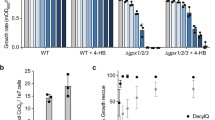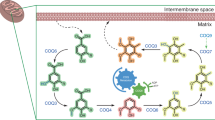Abstract
Unlike most other organisms, the essential five-step coenzyme A biosynthetic pathway has not been fully resolved in yeast. Specifically, the genes encoding the phosphopantothenoylcysteine decarboxylase (PPCDC) activity still remain unidentified. Sequence homology analyses suggest three candidates—Ykl088w, Hal3 and Vhs3—as putative PPCDC enzymes in Saccharomyces cerevisiae. Notably, Hal3 and Vhs3 have been characterized as negative regulatory subunits of the Ppz1 protein phosphatase. Here we show that YKL088w does not encode a third Ppz1 regulatory subunit, and that the essential roles of Ykl088w and the Hal3 and Vhs3 pair are complementary, cannot be interchanged and can be attributed to PPCDC-related functions. We demonstrate that while known eukaryotic PPCDCs are homotrimers, the active yeast enzyme is a heterotrimer that consists of Ykl088w and Hal3/Vhs3 monomers that separately provides two essential catalytic residues. Our results unveil Hal3 and Vhs3 as moonlighting proteins involved in both CoA biosynthesis and protein phosphatase regulation.
This is a preview of subscription content, access via your institution
Access options
Subscribe to this journal
Receive 12 print issues and online access
$259.00 per year
only $21.58 per issue
Buy this article
- Purchase on Springer Link
- Instant access to full article PDF
Prices may be subject to local taxes which are calculated during checkout






Similar content being viewed by others
References
Begley, T.P., Kinsland, C. & Strauss, E. The biosynthesis of coenzyme A in bacteria. Vitam. Horm. 61, 157–171 (2001).
Mercer, A.C. & Burkart, M.D. The ubiquitous carrier protein–a window to metabolite biosynthesis. Nat. Prod. Rep. 24, 750–773 (2007).
Daugherty, M. et al. Complete reconstitution of the human coenzyme A biosynthetic pathway via comparative genomics. J. Biol. Chem. 277, 21431–21439 (2002).
Kupke, T., Hernandez-Acosta, P. & Culianez-Macia, F.A. 4′-phosphopantetheine and coenzyme A biosynthesis in plants. J. Biol. Chem. 278, 38229–38237 (2003).
Ye, Y., Osterman, A., Overbeek, R. & Godzik, A. Automatic detection of subsystem/pathway variants in genome analysis. Bioinformatics 21 Suppl 1: i478–i486 (2005).
Osterman, A. & Overbeek, R. Missing genes in metabolic pathways: a comparative genomics approach. Curr. Opin. Chem. Biol. 7, 238–251 (2003).
Kupke, T., Hernandez-Acosta, P., Steinbacher, S. & Culianez-Macia, F.A. Arabidopsis thaliana flavoprotein AtHAL3a catalyzes the decarboxylation of 4′-Phosphopantothenoylcysteine to 4′-phosphopantetheine, a key step in coenzyme A biosynthesis. J. Biol. Chem. 276, 19190–19196 (2001).
Strauss, E., Kinsland, C., Ge, Y., McLafferty, F.W. & Begley, T.P. Phosphopantothenoylcysteine synthetase from Escherichia coli. Identification and characterization of the last unidentified coenzyme A biosynthetic enzyme in bacteria. J. Biol. Chem. 276, 13513–13516 (2001).
Hernandez-Acosta, P., Schmid, D.G., Jung, G., Culianez-Macia, F.A. & Kupke, T. Molecular characterization of the Arabidopsis thaliana flavoprotein AtHAL3a reveals the general reaction mechanism of 4′-phosphopantothenoylcysteine decarboxylases. J. Biol. Chem. 277, 20490–20498 (2002).
Steinbacher, S. et al. Crystal structure of the plant PPC decarboxylase AtHAL3a complexed with an ene-thiol reaction intermediate. J. Mol. Biol. 327, 193–202 (2003).
Strauss, E., Zhai, H., Brand, L.A., McLafferty, F.W. & Begley, T.P. Mechanistic studies on phosphopantothenoylcysteine decarboxylase: trapping of an enethiolate intermediate with a mechanism-based inactivating agent. Biochemistry 43, 15520–15533 (2004).
Ferrando, A., Kron, S.J., Rios, G., Fink, G.R. & Serrano, R. Regulation of cation transport in Saccharomyces cerevisiae by the salt tolerance gene HAL3. Mol. Cell. Biol. 15, 5470–5481 (1995).
Di Como, C.J., Bose, R. & Arndt, K.T. Overexpression of SIS2, which contains an extremely acidic region, increases the expression of SWI4, CLN1 and CLN2 in sit4 mutants. Genetics 139, 95–107 (1995).
Ariño, J. Novel protein phosphatases in yeast. Eur. J. Biochem. 269, 1072–1077 (2002).
de Nadal, E. et al. The yeast halotolerance determinant Hal3p is an inhibitory subunit of the Ppz1p Ser/Thr protein phosphatase. Proc. Natl. Acad. Sci. USA 95, 7357–7362 (1998).
Posas, F., Camps, M. & Ariño, J. The PPZ protein phosphatases are important determinants of salt tolerance in yeast cells. J. Biol. Chem. 270, 13036–13041 (1995).
Yenush, L., Mulet, J.M., Ariño, J. & Serrano, R. The Ppz protein phosphatases are key regulators of K+ and pH homeostasis: implications for salt tolerance, cell wall integrity and cell cycle progression. EMBO J. 21, 920–929 (2002).
Ruiz, A., Yenush, L. & Ariño, J. Regulation of ENA1 Na(+)-ATPase gene expression by the Ppz1 protein phosphatase is mediated by the calcineurin pathway. Eukaryot. Cell 2, 937–948 (2003).
Lee, K.S., Hines, L.K. & Levin, D.E. A pair of functionally redundant yeast genes (PPZ1 and PPZ2) encoding type 1-related protein phosphatases function within the PKC1-mediated pathway. Mol. Cell. Biol. 13, 5843–5853 (1993).
Merchan, S., Bernal, D., Serrano, R. & Yenush, L. Response of the Saccharomyces cerevisiae Mpk1 mitogen-activated protein kinase pathway to increases in internal turgor pressure caused by loss of Ppz protein phosphatases. Eukaryot. Cell 3, 100–107 (2004).
Clotet, J., Gari, E., Aldea, M. & Ariño, J. The yeast ser/thr phosphatases sit4 and ppz1 play opposite roles in regulation of the cell cycle. Mol. Cell. Biol. 19, 2408–2415 (1999).
Munoz, I., Simon, E., Casals, N., Clotet, J. & Ariño, J. Identification of multicopy suppressors of cell cycle arrest at the G1-S transition in Saccharomyces cerevisiae. Yeast 20, 157–169 (2003).
Ruiz, A. et al. Functional characterization of the Saccharomyces cerevisiae VHS3 gene: a regulatory subunit of the Ppz1 protein phosphatase with novel, phosphatase-unrelated functions. J. Biol. Chem. 279, 34421–34430 (2004).
Giaever, G. et al. Functional profiling of the Saccharomyces cerevisiae genome. Nature 418, 387–391 (2002).
Espinosa-Ruiz, A., Belles, J.M., Serrano, R. & Culianez-Macia, F.A. Arabidopsis thaliana AtHAL3: a flavoprotein related to salt and osmotic tolerance and plant growth. Plant J. 20, 529–539 (1999).
Albert, A. et al. The X-ray structure of the FMN-binding protein AtHal3 provides the structural basis for the activity of a regulatory subunit involved in signal transduction. Structure 8, 961–969 (2000).
Strauss, E. & Begley, T.P. Mechanistic studies on phosphopantothenoylcysteine decarboxylase. J. Am. Chem. Soc. 123, 6449–6450 (2001).
Strauss, E. & Begley, T.P. Stereochemical studies on phosphopantothenoylcysteine decarboxylase from Escherichia coli. Bioorg. Med. Chem. Lett. 13, 339–342 (2003).
Kupke, T. & Schwarz, W. 4′-phosphopantetheine biosynthesis in Archaea. J. Biol. Chem. 281, 5435–5444 (2006).
de Nadal, E., Fadden, R.P., Ruiz, A., Haystead, T. & Ariño, J. A role for the Ppz Ser/Thr protein phosphatases in the regulation of translation elongation factor 1Balpha. J. Biol. Chem. 276, 14829–14834 (2001).
Costigan, C., Kolodrubetz, D. & Snyder, M. NHP6A and NHP6B, which encode HMG1-like proteins, are candidates for downstream components of the yeast SLT2 mitogen-activated protein kinase pathway. Mol. Cell. Biol. 14, 2391–2403 (1994).
Gavin, A.C. et al. Proteome survey reveals modularity of the yeast cell machinery. Nature 440, 631–636 (2006).
Brown, M.T., Goetsch, L. & Hartwell, L.H. MIF2 is required for mitotic spindle integrity during anaphase spindle elongation in Saccharomyces cerevisiae. J. Cell Biol. 123, 387–403 (1993).
Kupke, T. et al. Molecular characterization of lantibiotic-synthesizing enzyme EpiD reveals a function for bacterial Dfp proteins in coenzyme A biosynthesis. J. Biol. Chem. 275, 31838–31846 (2000).
Hazbun, T.R. et al. Assigning function to yeast proteins by integration of technologies. Mol. Cell 12, 1353–1365 (2003).
Krogan, N.J. et al. Global landscape of protein complexes in the yeast Saccharomyces cerevisiae. Nature 440, 637–643 (2006).
Collins, S.R. et al. Toward a comprehensive atlas of the physical interactome of Saccharomyces cerevisiae. Mol. Cell. Proteomics 6, 439–450 (2007).
Spitzer, E.D. & Weiss, B. dfp Gene of Escherichia coli K-12, a locus affecting DNA synthesis, codes for a flavoprotein. J. Bacteriol. 164, 994–1003 (1985).
Spitzer, E.D., Jimenez-Billini, H.E. & Weiss, B. beta-Alanine auxotrophy associated with dfp, a locus affecting DNA synthesis in Escherichia coli. J. Bacteriol. 170, 872–876 (1988).
Dujon, B. Yeasts illustrate the molecular mechanisms of eukaryotic genome evolution. Trends Genet. 22, 375–387 (2006).
Munoz, I. et al. Functional characterization of the yeast Ppz1 phosphatase inhibitory subunit Hal3: a mutagenesis study. J. Biol. Chem. 279, 42619–42627 (2004).
Bucovaz, E.T., Macleod, R.M., Morrison, J.C. & Whybrew, W.D. The coenzyme A-synthesizing protein complex and its proposed role in CoA biosynthesis in bakers' yeast. Biochimie 79, 787–798 (1997).
Bucovaz, E.T. et al. Coenzyme A-synthesizing protein complex of Saccharomyces cerevisiae. Mol. Cell. Biochem. 30, 7–26 (1980).
Olzhausen, J., Schubbe, S. & Schuller, H.J. Genetic analysis of coenzyme A biosynthesis in the yeast Saccharomyces cerevisiae: identification of a conditional mutation in the pantothenate kinase gene CAB1. Curr. Genet. 55, 163–173 (2009).
Gancedo, C. & Flores, C.L. Moonlighting proteins in yeasts. Microbiol. Mol. Biol. Rev. 72, 197–210 (2008).
Adams, A., Gottschling, D.E., Kaiser, C.A. & Stearns, T. Methods in Yeast Genetics (Cold Spring Harbor Laboratory Press, Cold Spring Harbor, New York, USA, 1997).
Treco, D.A. & Winston, F. Growth and manipulation of yeast. in Current Protocols in Molecular Biology (eds. Ausubel, F.M. et al.) 13.2.10–13.2.12 (John Wiley & Sons, New York, 1998).
Garcia-Gimeno, M.A., Munoz, I., Ariño, J. & Sanz, P. Molecular characterization of Ypi1, a novel Saccharomyces cerevisiae type 1 protein phosphatase inhibitor. J. Biol. Chem. 278, 47744–47752 (2003).
Meyer, C.R., Rustin, P. & Wedding, R.T. A simple and accurate spectrophotometric assay for phosphoenolpyruvate carboxylase activity. Plant Physiol. 86, 325–328 (1988).
Choi, J.H., Jung, H.Y., Kim, H.S. & Cho, H.G. PhyloDraw: a phylogenetic tree drawing system. Bioinformatics 16, 1056–1058 (2000).
Acknowledgements
Thanks are given to B. Weiss (Emory University School of Medicine) for E. coli strain BW369, to A. Osterman (Burnham Institute for Medical Research) for the human PPCDC cDNA and to R. Serrano (Instituto de Biología Molecular y Celular de Plantas, Universidad Politécnica de Valencia-Consejo Superior de Investigaciones Científicas) and P. Sanz (Instituto de Biomedicina de Valencia, Consejo Superior de Investigaciones Científicas) for diverse constructs and plasmids. We thank H. Ceulemans, E. Simón, A. Barceló and A. Vivó for their contribution in different phases of the project. The excellent technical assistance of A. Vilalta, M.J. Álvarez and M. Robledo is acknowledged. This work was supported by grants BFU2005-06388-C4-04-BMC and BFU2008-04188-C03-01 to J.A. (Ministerio de Educación y Ciencia, Spain and Fondo Europeo de Desarrollo Regional) and grant FA2007041600013 to E.S. (National Research Foundation, South Africa). J.A. is recipient of an “Ajut de Suport a les Activitats dels Grups de Recerca” (2009SGR-1091, Generalitat de Catalunya). A.G. was recipient of a fellowship from the Spanish Ministry of Education and Science. J.A. and E.S. are recipients of a Spain/South Africa Research Cooperation grant (HS2007-0022) from the National Research Foundation (South Africa) and the Ministerio de Educación y Ciencia (Spain). J.A. dedicates this paper to the memory of his father.
Author information
Authors and Affiliations
Contributions
A.R. performed genetic, phenotypic and biochemical experiments. A.G. performed genetic experiments, prepared recombinant proteins and carried out binding and cross-linking experiments and in vitro activity measurements. I.M. and R.S. performed genetic experiments. J.A.A. prepared recombinant proteins and performed in vitro activity measurements. E.S. and J.A. directed the research and co-wrote the paper.
Corresponding author
Supplementary information
Supplementary Text and Figures
Supplementary Figures 1–4, Supplementary Tables 1–3 and Supplementary Methods (PDF 799 kb)
Rights and permissions
About this article
Cite this article
Ruiz, A., González, A., Muñoz, I. et al. Moonlighting proteins Hal3 and Vhs3 form a heteromeric PPCDC with Ykl088w in yeast CoA biosynthesis. Nat Chem Biol 5, 920–928 (2009). https://doi.org/10.1038/nchembio.243
Received:
Accepted:
Published:
Issue Date:
DOI: https://doi.org/10.1038/nchembio.243
This article is cited by
-
Sis2 regulates yeast replicative lifespan in a dose-dependent manner
Nature Communications (2023)
-
Nascent peptide-induced translation discontinuation in eukaryotes impacts biased amino acid usage in proteomes
Nature Communications (2022)
-
Inhibiting Mycobacterium tuberculosis CoaBC by targeting an allosteric site
Nature Communications (2021)
-
Yeast Ppz1 protein phosphatase toxicity involves the alteration of multiple cellular targets
Scientific Reports (2020)
-
MdHAL3, a 4′-phosphopantothenoylcysteine decarboxylase, is involved in the salt tolerance of autotetraploid apple
Plant Cell Reports (2020)



